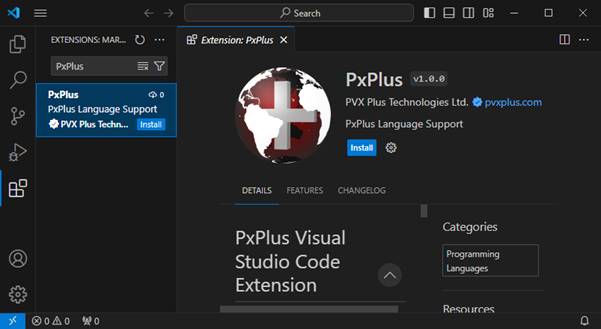
|
PxPlus Visual Studio Code Extension |
The PxPlus Visual Studio Code extension is an extension for Visual Studio Code to enable working with PxPlus programs.
It provides the following functionality:
See the tutorial How to Set Up and Use the PxPlus Visual Studio Code Extension.
(The PxPlus Visual Studio Code extension was added in PxPlus 2024.)

|
1. |
Download and install Visual Studio Code from the Visual Studio Code Web site https://code.visualstudio.com/ for your platform (i.e. Windows). If you are new to Visual Studio Code, this Web site is a great resource to learn more about it. |
|
2. |
On the Activity Bar on the far left side of Visual Studio Code, click the Extension icon. This displays the Extensions view and the Extensions Marketplace. |
|
3. |
Find the PxPlus extension by entering PxPlus in the Search Extensions in Marketplace input box. |
|
4. |
In the list that displays, click on PxPlus and then click the Install button to install the PxPlus extension. |
Before you can use the PxPlus Visual Studio Code extension, you must tell the extension where PxPlus is installed.
|
5. |
Open the Visual Studio Code settings by clicking the Gear icon in the bottom left corner and then select Settings from the menu that displays. |
|
6. |
Expand the Extensions node and then select the PxPlus node. |
|
7. |
Under PxPlus Path, enter the path to the directory where the PxPlus executable is located (i.e. C:\PVX Plus Technologies\PxPlus 2024). |
If you plan to work with text-based PxPlus programs, then you must also specify which file extensions Visual Studio Code should consider a text-based PxPlus program:
|
8. |
Under Text Program File Extensions, add a file extension to the list by clicking the Add Item button. Enter a .xxx file extension and then click OK. To add more than one file extension, repeat this step as many times as needed. By default, the only extension on the list is .pxprg. |
For a description of these and other settings, see PxPlus Extension Settings.
With the extension set up, you can now work with PxPlus programs. You can create new PxPlus programs, as well as open and edit existing PxPlus programs.
To Create New PxPlus Programs:
|
1. |
From the File menu or from the Welcome screen, select New File. You can also right click in the Explorer and select Create New PxPlus Program. |
|
2. |
A list of possible file types to create will display. From the list, select Create a PxPlus Program. |
|
3. |
Use the Save dialog to choose a pathname for your new program. |
To Edit Existing PxPlus Programs:
To start editing PxPlus programs, you first need to add a PxPlus folder to the workspace. This is initiated by using one of the following methods:
This will allow you to select a PxPlus folder to add to the workspace.
Any PxPlus programs or text-based PxPlus programs that are opened via this workspace will be recognized as a PxPlus program by Visual Studio Code. This enables all the features and allows PxPlus programs to be edited.
This table describes the settings:
|
Setting |
Description |
|
PxPlus Path |
(Required) Specify the path to the directory where the PxPlus executable is located (i.e. C:\PVX Plus Technologies\PxPlus 2024). |
|
Text Program File Extensions |
Specify the file extensions that Visual Studio Code should consider a text-based PxPlus program. (Default: .pxprg) To add a new extension, click the Add Item button. To edit an existing extension, click the Pencil button beside the item. To delete an extension, click the X button beside the item. |
|
Maximum Number Of Problems |
This setting controls the maximum number of problems reported for PxPlus programs. (Default: 100) |
|
Lowercase Directives |
Displays the code with lowercase directives. (Default: Off) |
|
Lowercase Variables |
Displays the code with lowercase variables. (Default: Off) |
|
Mixed Case Variables |
Displays the code with mixed case variables. (Default: On) |
|
Suppress LET |
Displays the code without LET directives. (Default: Off) |
How to Set Up and Use the PxPlus Visual Studio Code Extension